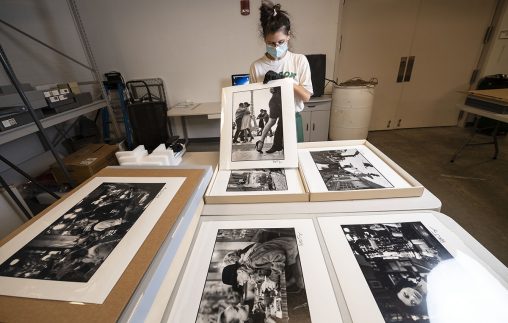Hundreds of photographs estimated in value at over $4 million taken by well-known photojournalists and fine art and documentary photographers have been donated to Wright State University, a gift that promises to put Robert and Elaine Stein Galleries on the map.
“It’s a significant acquisition for the university gallery,” said John Dickinson, associate professor of sculpture. “The sheer volume of photographs distinguishes us in the region as a prominent destination for seeing fine art photography.”
Dickinson said the works support the aim of the Stein Galleries to collect and show modern and contemporary art of the highest caliber.
“A lively variation of style and approach are captured by the collection,” he said. “Ranging from black-and-white documentary photographs to experimental image-making processes, such a varied selection will benefit our students and the public alike.”
The donation includes 873 works by artists that include Kristin Capp, Donna Ferrato, Larry Fink, Sally Gall, Ralph Gibson, Walter Iooss, Alen MacWeeney, Raphael Mazzucco, David Seltzer, Joyce Tenneson and Peter Turnley.
The gift, which has yet to be officially appraised, was donated anonymously and on condition that the collection not be sold by the university. The galleries received a donation of 50 to 75 works from the same donors last year.
“This donation has probably quadrupled our collection of photographs in the Stein Galleries’ Permanent Collection, and we look forward to finding ways to showcase the images to students and the community,” said Tracy Longley-Cook, associate professor of photography.
Katherine Ryckman Siegwarth, the Kettering curator of photography and special projects at the Dayton Art Institute, said photography is fundamental to how many people process the world.
“Galleries that collect and display photography provide an accessible entry point to consider a variety of aesthetic, philosophical and social concepts,” she said. “This gift, which ranges from photojournalism, candid society portraits and sport photography, has ample opportunities for exhibition display and demonstrates the array of strategies that artists can use this media.”
Longley-Cook said other departments around Wright State could enhance their curriculum by viewing the photographs.
“Donna Ferrato is well known for her intensely amazing portfolio ‘Living with the Enemy,’ which documents the sad reality of domestic abuse,” said Longley-Cook. “We received a sizable selection of images from that portfolio. Perhaps women’s studies or criminology classes could use these photographs as a foundation to discuss the larger issues regarding that topic.”
Funding is being explored to frame and formally display the photographs. There has been discussion of designating a space in the galleries for the continuous display of a rotating selection of the donation.
Longley-Cook said she hopes to get professors, the Dayton community and the photographic community to bring people in to see the powerful artwork once it is safe to do so with the COVID-19 pandemic.
“We are faced with the hardship of having an amazing collection that few will be able to see for the time being,” said Longley-Cook. “I hope this will soon change so we may be able to make the Stein Galleries more of a regional or hopefully national destination to view such a strong and valuable collection.”
Siegwarth said seeing artwork in person is important even though virtual platforms have extended the ability to engage with collections and allowed for in-depth discussions and connections.
“This creates exciting context for understanding themes, exhibitions and artworks, but does not outweigh the experience of seeing the photographs and artworks in person,” she said. “The physical response of reviewing an artwork — not a back-lit, flat reproduction — remains my favorite aspect of visiting a museum or gallery.”
Dickinson said it is fortunate that the Stein Galleries have facilities equipped to safely store and display such a sizeable gift. His hope is that the donation will not only strengthen existing relationships with organizations like the Cincinnati-based nonprofit FotoFocus but will also make inroads to new areas of the community and generate broad interest in the gallery and the Department of Art and Art History.


 Wright State University Foundation awards 11 Students First Fund projects
Wright State University Foundation awards 11 Students First Fund projects  Gov. DeWine reappoints Board Treasurer Beth Ferris and names student Ella Vaught to Wright State Board of Trustees
Gov. DeWine reappoints Board Treasurer Beth Ferris and names student Ella Vaught to Wright State Board of Trustees  Joe Gruenberg’s 40-Year support for Wright State celebrated with Honorary Alumnus Award
Joe Gruenberg’s 40-Year support for Wright State celebrated with Honorary Alumnus Award  Wright State’s elementary education program earns A+ rating for math teacher training
Wright State’s elementary education program earns A+ rating for math teacher training  Wright State’s Calamityville hosts its largest joint medical training operation
Wright State’s Calamityville hosts its largest joint medical training operation 